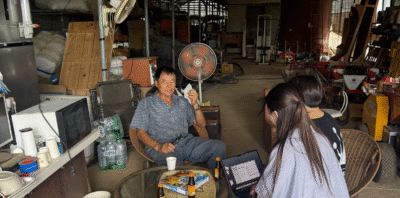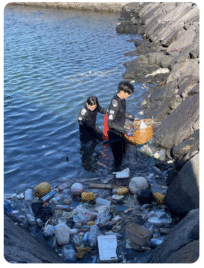Plogging Through Sinsa-dong
Turning Jogging into Action
Last weekend, we joined a plogging activity in Sinsa-dong, Seoul, as part of the Spiritus First Good Influence Challenge. Plogging combines jogging with picking up litter, and this simple act gave us more than just a workout. It helped us better understand what kinds of waste are most common in urban areas—and what those patterns reveal about everyday habits.
Mapping the Waste
To make our efforts more meaningful, we recorded all the collected trash on eco1365, a public environmental data platform. Each piece of waste was tagged by type and location, creating a detailed waste map of the Gangnam district.
This data-driven approach helps visualize where trash tends to accumulate and what materials are most problematic in specific zones. By turning cleanup data into insight, we hope to support better planning for future environmental efforts.

What We Found
In total, our team collected 63 pieces of litter during the activity. Here’s the breakdown:
- Cigarette butts: 32 pieces (≈50.8%)
- Plastic waste: 17 pieces (≈27%)
- Paper waste: 6 pieces
- Metal/Cans: 4 pieces
- Vinyl waste: 3 pieces
- Other: 1 piece
More than half of the waste consisted of cigarette butts. While Sinsa-dong is known for its cafés, restaurants, and nightlife, it became clear that small, easily overlooked litter remains a major issue. The streets may appear clean, but a closer look reveals hidden pollution that accumulates quietly over time.
Why It Matters

Cigarette butts might seem harmless because of their size, but they pose a serious threat to the environment. They contain toxic substances such as nicotine and heavy metals, which can leach into soil and water. Because they are small and difficult to collect, they often escape notice by both the public and cleaning crews, gradually building up and harming local ecosystems.
What We Can Do
We identified two simple but effective steps to reduce this issue:
- Make smoking zones more visible and accessible Many smokers litter because proper disposal areas are not clearly available. Installing more designated smoking zones with ashtrays near popular areas like cafés and restaurants could reduce illegal littering. Clear signage and easy access are key to changing habits.
- Raise awareness through education Most littering happens out of habit, not intention. Public campaigns, posters, and social media initiatives can help people understand how damaging cigarette butts really are. Collaborating with schools, local businesses, and influencers can amplify this message and make environmental responsibility a shared community effort.
What We Learned
This plogging activity reminded us that small actions can create real change. Picking up litter was important, but so was understanding the patterns behind it. The data we gathered revealed a hidden problem—and inspired us to think about long-term, community-based solutions.
We plan to continue plogging in other neighborhoods and compare the data we collect. Every area tells its own story, and together, these stories can shape stronger environmental policies and better public habits.
At Spiritus, we believe that purposeful action, even in its smallest form, can lead to lasting change. A single piece of litter may seem insignificant, but when we act together, our collective efforts can transform both the environment and our mindset.
Discover more from Spiritus Blog
Subscribe to get the latest posts sent to your email.



